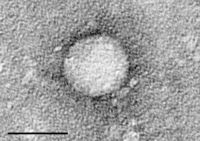
Photo from wikipedia
Abstract Hepatitis C virus (HCV), which infected 71 million worldwide and about 5%–6% are from Pakistan, is an ssRNA virus, responsible for end‐stage liver disease. To date, no effective therapy… Click to show full abstract
Abstract Hepatitis C virus (HCV), which infected 71 million worldwide and about 5%–6% are from Pakistan, is an ssRNA virus, responsible for end‐stage liver disease. To date, no effective therapy is available to cure this disease. Hence, it is important to study the most prevalent genotypes infecting human population and design novel vaccine or small molecule inhibitors to control the infections associated with HCV. Therefore, in this study clinical samples (n = 35; HCV-3a) from HCV patients were subjected to Sanger sequencing method. The sequencing of the core gene, which is generally considered as conserved, involved in the detection, quantitation and genotyping of HCV was performed. Multiple mutations, that is, R46C, R70Q, L91C, G60E, N/S105A, P108A, N110I, S116V, G90S, A77G and G145R that could be linked with response to antiviral therapies were detected. Phylogenetic analysis suggests emerging viral isolates are circulating in Pakistan. Using ab initio modelling technique, we predicted the 3D structure of core protein and subjected to molecular dynamics simulation to extract the most stable conformation of the structure for further analysis. Immunoinformatic approaches were used to propose a multi-epitopes vaccine against HCV by using core protein. The vaccine constructs consist of nine CTL and three HTL epitopes joined by different linkers were docked against the two reported Toll-like receptors (TLR-3 and TLR-8). Docking of vaccine construct with TLR-3 and TLR-8 shows proper binding and in silico expression of the vaccine resulted in a CAI value of 0.93. These analyses suggest that specific immune responses may be produced by the proposed vaccine. Communicated by Ramaswamy H. Sarma
Journal Title: Journal of Biomolecular Structure and Dynamics
Year Published: 2020
Link to full text (if available)
Share on Social Media: Sign Up to like & get
recommendations!